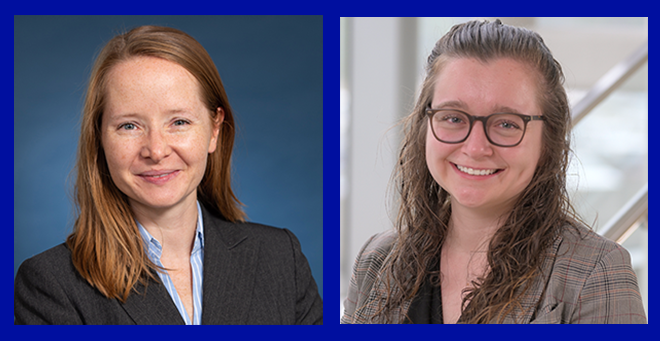
Roughly one-third of surveyed pregnant patients with or at risk for hypertensive disorders of pregnancy (HDP) reported food insecurity, according to a study presented by UMass Chan Medical School researchers at the American College of Cardiology Scientific Session, held in April in Atlanta.
The study by third-year internal medicine resident Katherine Sadaniantz, MD’21, and Lara Kovell, MD, MSCI’24, associate professor of medicine and obstetrics & gynecology, looked at responses from 53 pregnant individuals with hypertension, HDP or at risk for HDP, who were receiving prenatal care at UMass Memorial Medical Center.
According to the researchers, literature on food security during pregnancy is scarce, but prior studies have suggested associations with lower and higher gestational weight gain, prepregnancy obesity and gestational diabetes. Healthy maternal dietary patterns, in contrast, may lower the odds of preeclampsia and other HDP.
“Hopefully this study and others like it help to support the policy change needed to enhance access and funding to food support programs and screening programs in pregnancy, in order to improve food security and health outcomes for pregnant individuals with these risk factors for cardiovascular disease,” Dr. Sadaniantz said.
Food insecurity, defined as uncertain access to food with or without hunger, affects more than 10 percent of U.S. families, the researchers noted.
“Food insecurity itself is associated with a higher body mass index (BMI),” Sadaniantz said. “While this may seem paradoxical, high energy-dense processed food tends to be lower cost compared with lower energy-dense, nutritious foods including lean meats, low-fat dairy products, fruits and vegetables. Additionally, food insecurity is associated with anxiety and depression, which may lead to emotional eating.”
“Both food insecurity and obesity can be consequences of inadequate income,” said Dr. Kovell.
Food insecure patients in the current study were significantly more likely to report barriers involving skills to plan or cook healthy foods, transportation, and home appliances or space.
Kovell said there is still a need for most health care practices to develop referral pathways and support once food insecurity is identified.
More than half of study participants who reported food insecurity were enrolled in federal food assistance programs such as Supplemental Nutrition Assistance Program (SNAP, sometimes known as food stamps) or Women, Infants and Children Nutrition Program (WIC); and interestingly, nearly 20 percent of participants who reported being food secure were also enrolled in federal programs, according to Sadaniantz.
But Sadaniantz said more needs to be done. “It has been found that earlier and longer engagement with WIC decreases food insecurity in pregnant individuals,” she said. “Additionally, in one study, involvement of low-income pregnant individuals who were food insecure in group prenatal care led to more food security by late pregnancy compared to usual care. This was despite no difference in WIC and SNAP participation, but perhaps due to sharing of experiences and resources.”
Sadaniantz pointed out that unconditional cash transfer programs in other countries have shown improvements in maternal and fetal outcomes as well as food security status.

